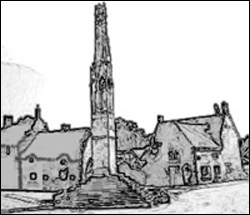![]()
The contents on this page remain on our website for informational purposes only.
Content on this page will not be reviewed or updated.
![]()
The contents on this page remain on our website for informational purposes only.
Content on this page will not be reviewed or updated.
|
QUEEN ELEANOR'S CROSS |
||||||||||
|
The Queen Eleanor Cross
Stony Stratford was one of the 12 sites of the memorial crosses erected for King Edward I's wife Queen Eleanor following her death in 1290. |
 |
|||||||||
|
||||||||||
| The Eleanor Cross which stood in a prominent position in the High Street of Stony Stratford, at the north end of the town near the river (see point 8 of the Town Tour), was a monument to the great love between King Edward I and his Queen Eleanor. | ||||||||||
| It was a marriage of convenience (a regular custom in those times) when Eleanor of Castile - just a child of 10 - married 15-year-old Edward of Westminster in 1254, five weeks before Michaelmas Day. Eleanor returned to her family following the marriage, whilst Edward continued his education - earning his 'spurs' at Tournaments and fighting in wars. Eleanor grew into a beautiful young woman, and Edward grew tall, earning the nickname 'Longshanks'. When they met again (probably when Eleanor was around 18 years old), it is said that they fell in love, even though their marriage had been a political arrangement rather than a romantic one. They had 15 children, although not all survived into adulthood. They became inseparable and unusually, Eleanor accompanied the King on Crusades to the Holy Lands. It was on such a Crusade that Edward was wounded in the arm by a poisoned knife, the story being that Eleanor herself sucked out the poison from the wound, thus saving his life. They were away on Crusade in 1272 when Edward's father King Henry III died. Edward immediately became King of England. Edward and Eleanor were finally crowned on return from the Crusades in 1274. They reigned for many years and were renowned for being close and much in love. |
||||||||||
In 1290, the King was in Scotland awaiting Eleanor's arrival on an important trip, when she was taken ill on the journey to meet him. She was diagnosed as suffering from a 'slow fever'. The Queen was taken to the nearby manor house of Richard de Weston at Harby near Lincoln. The King, on hearing the news, travelled to be at her side but Eleanor failed to respond to treatments and died (it is thought most likely) on the evening of 28th November 1290. Edward was grief-stricken and shut himself away for several days, possibly planning memorials to his beloved Queen Eleanor and her final trip back home to London to her resting place. The Queen's body was first taken to Lincoln for embalming at St. Catherine's Priory. The viscera were buried in a tomb in Lincoln Cathedral, a place she was said to have had fond memories for, and her heart was buried at Blackfriars Church in London (at her request) as was the custom of those times. Her body was taken to Westminster Abbey for burial in a tomb.
The journey took many days and many people were involved in the solemn task of moving her coffin through the country on it's journey to London. King Edward later declared that to honour Eleanor, a memorial would be erected wherever the Queen's body had rested on its journey home to Westminster. Crosses of this nature were erected in the hope that pilgrims and those passing by would pray for the soul of the Queen and so hasten her journey from purgatory into paradise. (In fact during those times, people were paid to pray regularly for the soul of important people, to speed their journey!). Edward probably chose this method of memorial having seen similar crosses erected in France and other parts of Europe on his travels. The resting places for the Queen's coffin and therefore sites for memorial crosses were: Lincoln, Grantham, Stamford, Geddington, Hardingstone, Stony Stratford, Woburn, Dunstable, St. Albans, Waltham, Cheapside (West Cheap), Charing Cross; and finally the coffin would have arrived at Westminster Abbey for a state burial. Only three of the original memorial crosses now remain - at Geddington, Hardingstone and Waltham. These will have been cleaned and possibly repaired over the centuries. The crosses themselves varied in size, as can be seen on the pictures of two of the crosses below. This was thought to be due to the different designers and builders of the crosses, rather than the importance of the place in which the cross stood.
Edward I outlived Queen Eleanor by seventeen years and did in fact marry again. He finally died of dysentery near Carlisle, in July 1307, aged 68. |
||||||||||
|
|
||||||||||
|
The Queen Eleanor Cross at Stony Stratford
|
||||||||||
 |
It is said that the Stony Stratford cross was a tall elegant design, and we can suppose that it looked similar to the cross at Geddington (pictured above).
The Commemorative Plaque reads: "Near this spot stood the Cross erected by King Edward the I to mark the place in Stony Stratford where the body of Queen Eleanor rested on its way from Harby in Nottinghamshire to Westminster Abbey in 1290" |
|||||||||
|
|
||||||||||
|
|
||||||||||